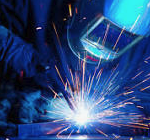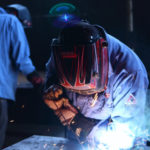Welding is a skilled trade with positions across a range of industries. But a welder’s job goes beyond the torch. They read blueprints, measure and fit parts, choose the right process, and perform safety and quality checks. Where they work is just as varied. Welders can work in shops, construction sites, shipyards, and manufacturing plants — both indoors and outdoors, sometimes on multiple shifts.
Considering pursuing a career in this field? It’s challenging, rewarding, and gives you the satisfaction of making something built to last. If you’ve ever wondered about welder job duties or asked “What do welders do every day?”, here’s a look inside what could be a typical shift.
A Welder’s Day, Hour by Hour
6:30 a.m. | Safety briefing, permits, and PPE
Every day starts with safety. The crew meets for a toolbox talk, reviewing hazards and the day’s assignments. Cables, leads, cylinders, and guards are inspected before striking an arc.
Personal protective equipment (PPE) is non-negotiable: a helmet with the right filter lens, flame-resistant clothing, gloves, safety glasses, and hearing protection. For some jobs, a respirator or fume extractor is also required.
Where hot work rules apply, welders sign a permit before starting. OSHA requires controls for welding and cutting, and the National Fire Protection Association (NFPA) emphasizes hot work permits for fire prevention.
ANSI Z49.1 is the core safety standard for welding and allied processes, widely followed in shops across the U.S.
7:00 a.m. | Review the job packet, WPS, and prints
Welders review their work package, which includes blueprints, weld symbols, and a Welding Procedure Specification (WPS). The WPS lists approved variables such as process, filler metal, shielding gas, amperage, voltage, travel speed, and preheat.
The American Welding Society publishes Standard Welding Procedure Specifications, which help maintain consistency across jobs.
7:30 a.m. | Fit-up and prep
Before welding, it’s time for material prep. That means identifying parts, cleaning mill scale, grinding bevels, setting root openings, and tacking joints. Precision is key.
9:00 a.m. | Process setup and first beads
Welders select the right process for the job:
- GMAW (MIG): Fast and efficient on carbon steel (AWS overview).
- GTAW (TIG): Precise, often used for stainless or thin materials.
- SMAW (Stick): Portable, reliable outdoors, tolerant of wind.
Choice depends on base metal, thickness, position, and productivity needs.
10:30 a.m. | Production welding and in-process checks
Now the welder is in full swing, producing joints while checking alignment and cleaning between passes. Heat must be balanced to avoid distortion.
12:00 p.m. | Lunch and equipment check
Welders often work full-time schedules with overtime or evening shifts. During breaks, machines, torches, consumables, and gas systems are inspected. Keeping tools in top condition prevents downtime.
12:30 p.m. | Quality verification
After welding, quality checks begin. Welders measure leg sizes and throat dimensions, looking for defects like porosity or undercut. Jobs may also require a quality inspector to test and verify the work through a range of testing methods.
2:00 p.m. | Secondary tasks and rework
Not every weld is perfect. When needed, welders grind, cut, or straighten materials before re-welding. The level of care and skill up to this point shows us: this trade takes training. Fortunately, programs like AAI’s Combination Welding program combine the technical knowledge with hands-on experience, helping students pick up the skills that employers may need.
3:30 p.m. | Paperwork, housekeeping, and handoff
The shift ends with documentation. This includes marking heat numbers, recording parameters, and updating travelers — a document that tracks the progress of a manufacturing project, step by step. Good housekeeping includes removing combustibles and performing a fire watch, as OSHA standards require.
Where Welders Work and Typical Schedules
Welders are employed in manufacturing plants, construction firms, specialty trade contractors, and repair shops. Some work outdoors in the field on pipelines or structural projects. Many shops operate two or three shifts of 8–12 hours, with weekend or evening work common when deadlines are tight (Bureau of Labor Statistics).
Ready to start your welding journey?
Welding is practical, demanding, and essential in industries across the country. If you want to learn the tools, processes, and safety practices welders use every day, Arizona Automotive Institute’s Combination Welding program offers hands-on training with guidance from industry-experienced instructors. Financial aid is available for those who qualify.
Frequently Asked Questions
What do welders do in their jobs?
Welders read blueprints, prepare and fit parts, select welding processes such as MIG, TIG, or stick, and perform welds that meet project requirements. They also maintain equipment and complete records
Do I need training to become a welder?
Most employers prefer candidates who have completed hands-on training. Technical programs, like those at AAI, provide practice with processes, safety procedures, and industry equipment.
Are welding jobs available in different industries?
Yes. Welders work in manufacturing, construction, specialty trade contractors, and repair services. Some also work on pipelines, shipyards, or structural steel projects.
What credentials matter for welders?
The NCCER (National Center for Construction Education and Research) welding credentials are widely recognized by employers. It validates essential skills and provides a pathway for advancement in the trade.
Do welders work full-time or shifts?
Welders can work full-time schedules. Many shops operate multiple shifts, which may include evenings, weekends, or overtime when projects require it.
Disclaimers: Information within this blog is for general information purposes only. AAI does not assume or guarantee employment, certification/licensures, specific job/career positions, income earning potential, or salary expectations based on the programs offered at AAI. Career and program information statements in this blog do not guarantee that programs or other information mentioned are offered at AAI.
Information within this blog is for general information purposes only. AAI does not assume or guarantee certification/licensures, specific job/career positions, income earning potential or salary expectations based on the programs offered at AAI. Career and program information statements in this blog do not guarantee that programs or other information mentioned are offered at AAI.





